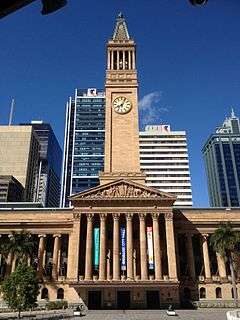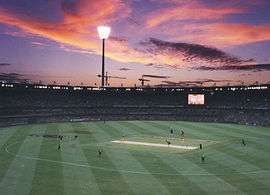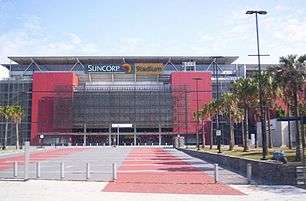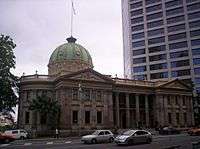Tourism in Brisbane
Tourism in Brisbane is an important industry for the Queensland economy, being the third-most popular destination for international tourists after Sydney and Melbourne.[1]
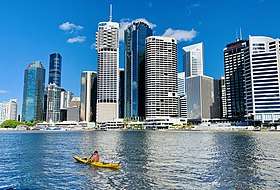
Brisbane is a popular tourist destination, serving as a gateway to the state of Queensland, particularly to the Gold Coast and the Sunshine Coast, which are home to numerous popular surf beaches, located immediately south and north of Brisbane respectively. Major landmarks and attractions include South Bank Parklands, the Queensland Cultural Centre (including the Queensland Museum, Queensland Art Gallery, Gallery of Modern Art, Queensland Performing Arts Centre and State Library of Queensland), City Hall, the Story Bridge, the City Botanic Gardens and Parliament of Queensland, the Howard Smith Wharves, ANZAC Square, Fortitude Valley (including James Street and Chinatown), West End, the Teneriffe woolstores precinct, Roma Street Parkland, New Farm Park (including the Brisbane Powerhouse), St John's Cathedral, the Lone Pine Koala Sanctuary, the Mount Coot-tha Lookout and Botanic Gardens, the D'Aguilar Range and National Park, the Brisbane River and its Riverwalk network, as well as Moreton Bay (including Moreton, North Stradbroke and Bribie islands, and coastal suburbs such as Shorncliffe, Wynnum and those on the Redcliffe Peninsula).
City landmarks

Story Bridge
The Story Bridge is a Brisbane icon, designed by Dr. John Bradfield, designer of the Sydney Harbour Bridge.[2] It spans Petrie Bight from Kangaroo Point to Fortitude Valley and totals 1,072 metres (3,517 ft) meters in length.[3]
Tourist groups run the Story Bridge Adventure Climb as well as the Abseil Climb, which provides daylight, twilight, and night tours.[4]
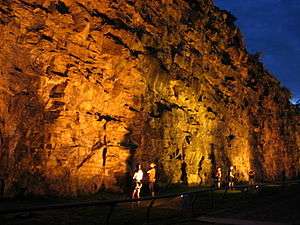
Brisbane City Hall
Brisbane's most famous landmark is Australia's largest and grandest city hall. It is home to the Museum of Brisbane and features the circular Concert Hall and a world-famous grand piano organ. Free tours are available of the city hall and its clock tower.[5][6]
The Brisbane City Hall contains the re-established historic Tudor-style Shingle Inn restaurant, with its original 1936 Tudor furnishing and fittings restored.[7]
Kangaroo Point Cliffs
The Kangaroo Point Cliffs extend south from just north of the former Naval Bridge Depot to the former South Brisbane Dry Dock, west of the Captain Cook Bridge. The rock comprising the cliffs was formed about 230 million years ago, but the cliffs as they are today were created by convicts quarrying the stone for the early colony.[8] The cliff are popular with rock climbers, and the park and gardens below are available for BBQs and picnics.[9]
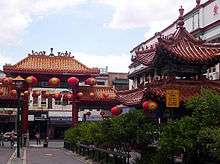
Fortitude Valley
The Valley experienced an urban renaissance in the 1980s and 1990s, when young people flocked to new nightclubs, some in place of the brothels and illegal gambling joints of an earlier era.[10] As more people lived in the suburb, social and religious developmental trends explain the present diverse nature of The Valley, characterised by commercial buildings, hotels and churches side by side with residential buildings.[11] James Street is a popular shopping street that straddles Fortitude Valley and the adjoing suburb of New Farm.

Treasury Building
The Conrad Treasury Casino, formerly the State Government of Queensland Treasury Building, is situated at 1-27 Queen St, right up at the top of the city near the Victoria Bridge. It was built on a site that had been earmarked for Government use since around 1825. Three stages of construction went into the completed building, starting with the William Street frontage.[12] Completed, occupied and opened officially in 1928 at a final cost of £137,817, it provided expansive space for its Treasury Building tenants. As State Government Departments moved into the nearby Executive Building in the 1980s, the Treasury Building and adjacent Land Administration Building were sold, and consequently redeveloped as the Conrad Treasury Casino and Hotel precinct.[13]
The Gabba
One of Australia's most famous sports stadiums, the Gabba was established in 1895 and hosts a number of sports including AFL, cricket, rugby league, rugby union, and baseball, as well as athletics and concerts. Its current seating capacity is 42,000.
Lang Park
Lang Park, also known as Suncorp Stadium, is a major sports stadium and is considered the best rectangular stadium in Australia. It was established in 1914 on the site of a former cemetery. The stadium hosts mainly rugby league and football, and is a venue of the State of Origin. Its current seating capacity is 52,500.
St John's Cathedral
St John's Cathedral is a Medieval gothic revival cathedral, and an international centre of pilgrimage attracting over 20,000 visitors annually from around the world. The cathedral is the centre for big diocesan events, and is a major centre for the arts and music with its own orchestra. St John's also has the largest cathedral organ in Australia, which hosts many concerts throughout the year.
Customs House
The Customs House is a Brisbane landmark known for its distinctive copper dome.[14] Originally constructed for the government, there is now a restaurant and function centre within the building, and regular concerts and art exhibitions are also held here.
Cultural attractions
Queensland Gallery of Modern Art
The Queensland Gallery of Modern Art has a total floor area of 25,000 square metres (269,098 sq ft). The Gallery holds mostly Queensland arts as well as a variety of artworks from around the world.
Queensland Museum
The Queensland Museum has various human and natural historical artefacts. It is located within the Queensland Cultural Centre at South Bank and has various cafes and restaurants within and surrounding its location across the Brisbane River from the Brisbane CBD.
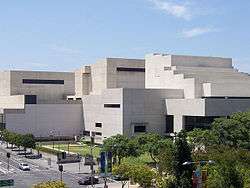
Queensland Performing Arts Centre
Also located within the Entertainment District of South Bank, the Queensland Performing Arts Centre has a number of theatres and auditoriums showcasing various famous shows and operas annually. Some of the most recognized shows featured at the centre include Mamma Mia!, The Phantom of the Opera, Wicked, Jersey Boys, and International Gala.
State Library of Queensland
The State Library of Queensland is Queensland's largest library, and contains extensive historical and archive materials.
Museum of Brisbane
The Museum of Brisbane is the City of Brisbane's official museum and is located in Brisbane City Hall. It features a changing exhibition program that celebrates Brisbane through social history, visual arts, craft and design.
Queensland Maritime Museum
The Queensland Maritime Museum is located adjacent to South Bank Parklands.
Parks and outdoor attractions
Brisbane's major parklands include the riverside City Botanic Gardens at Gardens Point, Roma Street Parkland, the 27-hectare Victoria Park at Spring Hill and Herston, South Bank Parklands along the river at South Bank, the Brisbane Botanic Gardens at Mount Coot-tha and the riverside New Farm Park at New Farm.
There are many national parks surrounding the Brisbane metropolitan area. The D'Aguilar National Park is a major national park along the northwest of the metropolitan area in the D'Aguilar Range. The Glass House Mountains National Park is located to the north of the metropolitan area in the Glass House Mountains and provides green space between the Brisbane metropolitan area and the Sunshine Coast. The Tamborine National Park at Tamborine Mountain is located in the Gold Coast hinterland to the south of the metropolitan area.
The eastern metropolitan area is built along the Moreton Bay Marine Park, encompassing Moreton Bay. Significant areas of Moreton, North Stradbroke and Bribie islands also covered by the Moreton Island National Park, Naree Budjong Djara National Park and the Bribie Island National Park respectively. The Boondall Wetlands in the suburb of Boondall include 1100 hectares of wetlands which are home to mangroves and shorebirds as well as walking tracks.
Mountains and national parks
There are many national parks surrounding the Brisbane metropolitan area which are popular recreational attractions for hiking and bushwalking. The D'Aguilar National Park runs along the northwest of the metropolitan area in the D'Aguilar Range, and contains popular bushwalking and hiking peaks at Mount Nebo, Camp Mountain, Mount Pleasant, Mount Glorious, Mount Samson and Mount Mee. The Glass House Mountains National Park is located to the north of the metropolitan area in the Glass House Mountains between it and that of the Sunshine Coast. The Tamborine National Park at Tamborine Mountain is located in the Gold Coast hinterland to the south of the metropolitan area. Moreton, North Stradbroke and Bribie islands are substantially covered by the Moreton Island National Park, Naree Budjong Djara National Park and the Bribie Island National Park respectively. The Boondall Wetlands in the suburb of Boondall are protected mangrove wetlands with floating walking trails.
Mount Coot-tha
The suburb Mount Coot-tha Reserve contains the Mount Coot-tha Botanic Gardens which house the Sir Thomas Brisbane Planetarium and the "Tsuki-yama-chisen" Japanese Garden (formerly of the Japanese Government Pavilion of Brisbane's World Expo '88). Atop the mountain is the Mount Coot-tha Lookout, providing views of the metropolitan area and Moreton Bay.
South Bank Parklands
South Bank Parklands attractions include the Wheel of Brisbane (a large ferris wheel), a swimming lagoon with sandy beaches, the South Bank Arbour,[15][16][17] rainforest walks, picnic areas and a picturesque riverfront promenade. Entertainment venues at South Bank Parklands include the Queensland Conservatorium Griffith University and Suncorp Piazza. South Bank Parklands are also home to the Lifestyle Markets on Fridays (5pm-10pm), Saturdays (11am-5pm) and Sundays (9am-5pm).
City Botanic Gardens
The City Botanic Gardens include Brisbane's most mature gardens, with many rare and unusual botanic species. In particular the Gardens feature a special collection of cycads, palms, figs and bamboo. The Gardens are located at Gardens Point, to the south-east of the CBD, within walking distance of the city centre.
New Farm Park
New Farm Park is a large heritage-listed riverfront public park covering 15 hectares (37 acres). It is located at the southeastern end of the New Farm peninsula within a bend in the Brisbane River.[18] The Powerhouse arts centre is at the eastern end of the park. The park also includes the New Farm Park ferry wharf and links to the Brisbane Riverwalk from Newstead to Toowong. It is one of Brisbane's most popular parklands and tourist attractions.
Roma Street Parkland
Roma Street Parkland is the world's largest subtropical garden in a city centre.[19] The parkland features a variety of themed gardens and recreational areas, with a web of pathways and boardwalks traversing cascading waterways and rocky outcrops, and in situ artworks by 16 local artists. Roma Street Parkland also has an open air amphitheatre (which was previously called the Albert Park Amphitheatre).
Moreton Bay
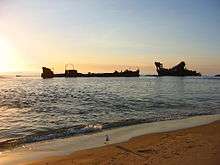
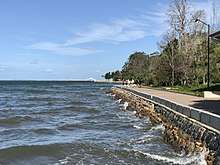
Moreton Bay and its marine park is also a major attraction, and its three primary islands Moreton Island, North Stradbroke Island and Bribie Island, accessible by ferry, contain popular surf beaches and resorts. Tangalooma resort on Moreton Island is popular for its nightly wild dolphin feeding attraction, and for operating Australia's longest running whale watching cruises. Beachside suburbs such as those on the Redcliffe Peninsula, as well as Shorncliffe, Sandgate, Wynnum, Manly and Wellington Point are also popular attractions for their bayside beaches, piers, and infrastructure for boating, sailing, fishing and kitesurfing.
Moreton Bay is on the east side of Brisbane, sheltered from the Pacific Ocean by two sand islands - Moreton Island to the north and North Stradbroke Island to the south. Activities here include sailing, boating, diving, windsurfing and fishing. Tangalooma, at the site of an old whaling station on the bay-side of Moreton Island, offers diving, whale-watching and dolphin tours. The two larger islands, and many of the smaller islands, for example, Coochiemudlo Island, Lamb Island and Russell Island, can be accessed by ferry. St Helena Island is near the mouth of the Brisbane River and is significant for its history as a penal colony, and its migratory birds.
Beachside suburbs that offer swimming and watersports include Wynnum, Manly, Shorncliffe, Sandgate and Wellington Point.
Nudgee Beach is a suburb about 18 kilometres (11 mi) outside of Brisbane. The beach is surrounded by numerous mangroves, and has a bike track that heads down to Boondall Wetlands.
Shopping
Retail in the CBD is centred around the Queen Street Mall, which is Australia's largest pedestrian mall. Shopping centres in the CBD include the Myer Centre, the Wintergarden, MacArthur Central and QueensPlaza, with the last of these along with Edward Street forming the city's focus for luxury brands. There are historical shopping arcades at Brisbane Arcade and Tattersalls Arcade. Suburbs adjacent to the CBD such as Fortitude Valley (particularly James Street), South Brisbane and West End are also a major inner-city retail hubs.
Outside of the inner-city, retail is focused on indoor shopping centres, including numerous regional shopping centres along with six super regional shopping centres, all of which are among Australia's largest, namely: Westfield Chermside in the north; Westfield Garden City in the south; Westfield Carindale in the east; Indooroopilly Shopping Centre in the west; Westfield North Lakes in the outer-north; and Logan Hyperdome in the outer-south. Brisbane's major factory outlet centres are the Direct Factory Outlets at Skygate and Jindalee.
The 100 hectare Brisbane Markets at Rocklea are Brisbane's largest wholesale markets, whilst smaller markets operate at numerous locations throughout the city including South Bank Parklands, Davies Park in West End, Queensland and the Eat Street Markets at Hamilton.
Queen Street Mall
Located in the centre of the city, the Queen Street Mall and its nearby surrounds is Queensland’s premier shopping destination. The mall is open plan, stretching half a kilometre along Queen Street Mall.[20] There are five major shopping centres, two department stores and four shopping arcades located within the mall.
Entertainment precincts
South Bank Parklands
South Bank Parklands, once the site of the Expo '88, is now an entertainment precinct boasting entertainment, cafes, restaurants, man-made beaches, lagoons, playgrounds and views of the city along its boardwalk. It is also the location for the Brisbane Convention and Exhibition Centre, and the temporary, relocatable Ferris wheel, the 60 metre Wheel of Brisbane.

Howard Smith Wharves
Howard Smith Wharves along the New Farm Cliffs below the Story Bridge is a stretch of riverside parkland which incorporates numerous entertainment and restaurant venues.
Eagle Street Pier
Eagle Street Pier is a riverside entertainment precinct which is home to numerous restaurants.
Portside Wharf
Portside Wharf, located approximately 7 kilometres (4.3 mi) from the Brisbane CBD on the Brisbane River, is a residential, retail precinct with numerous cafes, restaurants, shops and cinemas.
Throughout Brisbane
RiverWalk
Brisbane is notable for its Brisbane Riverwalk network, which runs along much of the Brisbane River foreshore throughout the inner-city area, with the longest span running between Newstead and Toowong. Another popular stretch runs beneath the Kangaroo Point Cliffs between South Brisbane and Kangaroo Point. Several spans of the Riverwalk are built out over the Brisbane River. Brisbane also has over 27 km (17 mi) of bicycle pathways, mostly surrounding the Brisbane River and city centre. Other popular recreation activities include the Story Bridge adventure climb and rock climbing at the Kangaroo Point Cliffs.
CityCat Ferries
CityCat Ferries are catamarans, and are a pleasant way to travel past such Brisbane icons as the Story Bridge and South Bank Parklands.[21]
City tours
Brisbane Greeters provide free walking tours around Brisbane, aiming to provide a customised, flexible, intimate and authentic experiences through a knowledgeable and enthusiastic local volunteer.[22]
Kangaroo Segway Tours offer tours of the city's major attractions using segways.[23]
Brisbane By Bicycle conduct daily tours of Brisbane city and surrounding areas in small groups. The tours are fully guided by a Brisbane local with extensive knowledge of the city including local bars, restaurants, events and attractions.[24]
Brisbane's Food Scene
Brisbane is home to over 6,000 restaurants and dining establishments,[25] with outdoor dining featuring prominently. The most popular cuisines by number of dining establishments are Japanese,[26] Chinese,[27] Modern Australian,[28] Italian,[29] American,[30] Indian,[31] and Vietnamese.[32] Moreton Bay bugs, less commonly known as flathead lobsters, are an ingredient named for the Brisbane region and which feature commonly in the city's cuisine, along with macadamia nuts, also native to the region. There are many Good Food Guide-awarded restaurants, cafes and bars in the region.[33]
Brisbane has a number of food markets to sample the local cuisine and street eats. Eat Street Markets at Hamilton and Boundary Street Markets at West End are popular weekend markets, especially with locals and offer a variety of cuisines from local restaurants and food trucks.[34][35]
Food Tours
Food tours provide great insight into a city’s local food scene, and Brisbane’s local food culture can be experienced on a tour with Delectable Tours.[36]
Other attractions
Lone Pine Koala Sanctuary
The Lone Pine Koala Sanctuary opened in 1927 and was the world's first koala sanctuary.[37] Wildlife in the sanctuary includes koalas, kangaroos, Tasmanian devils, wombats, echidnas, various species of reptiles, as well as many types of Australian birds. The sanctuary is located in the Brisbane suburb of Fig Tree Pocket.
Brisbane Tramway Museum
Brisbane Tramway Museum is a transport museum which preserves and displays trams and trolley-buses, most of which operated in Brisbane, Queensland, Australia. The museum also has a collection of vehicles and other equipment used in maintaining Brisbane's electric street transport system which operated from 1897 to 1969. The museum is located at Ferny Grove, a north-west suburb of Brisbane.
Newstead House
Newstead House, in Newstead Park, is the oldest house in Brisbane. Built in 1846, it is now a museum and heritage listed site. It is open to the public, and concerts are sometimes held at the house and grounds.
Day trips
The Gold Coast and Hinterland

The Gold Coast is a strip of urban areas and beaches located about 78 kilometres (48 mi) south of Brisbane, about an hour's travel by car or train.[38] Major centres with shopping, restaurants and sandy beaches include Surfers Paradise, Mermaid Beach, Burleigh Heads and Coolangatta. There are several theme parks in the region, including Movie World, Sea World, Wet'n'Wild Water World and Dreamworld, and wildlife parks such as David Fleay Wildlife Park and Currumbin Wildlife Sanctuary.
The Gold Coast hinterland features rainforests and wet sclerophyll forest with walking tracks and picnic areas. Some areas also offer camping sites, bed-and-breakfast accommodation, cafes and markets. Popular areas for tourism include Springbrook National Park, Lamington National Park and Tamborine Mountain. The Hinterland is promoted as "The Green Behind The Gold".
Bribie Island
Bribie Island is a sand island north of Brisbane, accessible by a road bridge over Pumicestone Passage. The area features a surf beach on the east side at Woorim, and quiet estuaries for boating and fishing on the west side, in the Passage. Accommodation is available in caravan parks. There are 4WD-accessible camping sites on the northern end of the island, which require permits. Attractions include the recently opened Bribie Island Seaside Museum, Passage cruises, and birdwatching at Buckley's Hole Environmental Park.
The Sunshine Coast and Hinterland
The Sunshine Coast, about an hour drive north of Brisbane, offers a wide range of beaches, national parks, theme parks and golf courses. Urban centres that cater for tourism along the coastline include Caloundra, Maroochydore, Noosa, and Coolum. To the west, the iconic Glasshouse Mountains offer scenic drives, lookouts, walking tracks and picnic areas. There is a ginger factory at Yandina, and Maleny and Montville offer art galleries, wineries, shops and cafes. The Woodford Folk Festival, an annual music festival, is held near the semi-rural town of Woodford, 72 kilometres (45 mi) north of Brisbane.
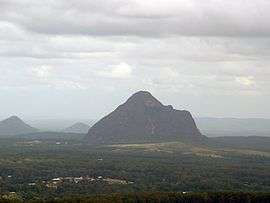
Rainbow Beach
Rainbow Beach is a coastal town in south-eastern Queensland, Australia, near Gympie, famed for its rainbow-coloured sand dunes, sand cliffs and pleasant beaches. The beach is located approximately 265 kilometres (165 mi) north of Brisbane, 76 kilometres (47 mi) east of Gympie and 700 metres west of Fraser Island on the Cooloola Coast.[39]
Kondalilla Falls National Park
Named after the spectacular Kondalilla Falls, where Skene Creek drops 90m into a rainforest valley, this park is a cool mountain retreat and an important refuge for many native animals and plants.[40] From Brisbane, the drive to the falls takes roughly 2 hours.
See also
References
- "International Market Tourism Facts" (PDF). Tourism Australia. Archived from the original (PDF) on 7 March 2008.
- Gregory, Helen (2007). Then and Now. 174 Cormack Road, Wingfield, South Australia 5013: Cameron house. p. 92. 9781741730111.CS1 maint: location (link)
- "Story Bridge (entry 600240)". Queensland Heritage Register. Queensland Heritage Council. Retrieved 15 August 2015.
- "City Hall Tours". Museum of Brisbane. Retrieved 21 October 2017.
- "Clock Tour tours". Museum of Brisbane. Retrieved 21 October 2017.
- "Our History". Shingle Inn. Archived from the original on 21 October 2017. Retrieved 21 October 2017.
- "Kangaroo Point Cliffs (entry 602400)". Queensland Heritage Register. Queensland Heritage Council. Retrieved 15 August 2015.
- "Kangaroo Point Information". Kangaroo Point. 2013. Retrieved 26 June 2013.
- The University of Queensland (2013). "Fortitude Valley". Centre for the Government of Queensland. Retrieved 26 June 2013.
- "A Brief History of Fortitude Valley". Valley community groups. 2001. Retrieved 27 June 2013.
- "Treasury Building". The Foto Fanatic. 2009. Retrieved 28 June 2013.
- "The Iconic Treasury Building - Heart of Government to Casino". Brisbane History. Retrieved 27 June 2013.
- Gregory, Helen (2007). Brisbane Then and Now. Wingfield, South Australia: Salamander Books. pp. 20–21. ISBN 978-1-74173-011-1.
- Things to Do - South Bank Corporation official website Archived 16 September 2008 at the Wayback Machine
- Master Plan Development - South Bank Corporation official website Archived 19 July 2008 at the Wayback Machine
- South Bank Arbour (fact sheet) — South Bank Corporation official website Archived 20 November 2008 at the Wayback Machine
- "New Farm - Brisbane Tourist Guide". e-CBD. Archived from the original on 16 December 2012. Retrieved 30 January 2013.
- Roma Street Parkland
- Brisbane Shopping Brisbane Tourism Guide. Retrieved on 2013-11-07.
- "Brisbane CityCat Ferry". Retrieved 7 November 2013.
- "Greeter FAQs | Brisbane Greeters - Visit Brisbane". Visit Brisbane. Retrieved 17 August 2016.
- "Brisbane Segway Tours". Retrieved 21 October 2017.
- "Brisbane Bike Tours | Brisbane By Bicycle". www.brisbanebybicycle.com.au. Retrieved 17 August 2016.
- "Brisbane restaurants". Zomato. Retrieved 2 May 2020.
- "Japanese restaurants in Brisbane". Zomato. Retrieved 2 May 2020.
- "Chinese restaurants in Brisbane". Zomato. Retrieved 2 May 2020.
- "Modern Australian restaurants in Brisbane". Zomato. Retrieved 2 May 2020.
- "Italian restaurants in Brisbane". Zomato. Retrieved 2 May 2020.
- "American restaurants in Brisbane". Zomato. Retrieved 2 May 2020.
- "Indian restaurants in Brisbane". Zomato. Retrieved 2 May 2020.
- "Vietnamese restaurants in Brisbane". Zomato. Retrieved 2 May 2020.
- "Eat & Drink - Visit Brisbane". Visit Brisbane. Retrieved 17 August 2016.
- "Eat Street Markets". Retrieved 21 October 2017.
- "Boundary Street Markets". Retrieved 21 October 2017.
- Planet, Lonely. "Brisbane Food Tour: A Taste of Queensland - Lonely Planet". Lonely Planet. Retrieved 17 August 2016.
- Gregory, Helen (2007). Brisbane Then and Now. Wingfield, South Australia: Salamander Books. p. 140. ISBN 978-1-74173-011-1.
- "Surfers Paradise Beach". Retrieved 4 November 2009.
- "Discover Rainbow Beach". Retrieved 4 November 2009.
- "Kondalilla National Park". Retrieved 4 November 2009.
External links
| Wikivoyage has a travel guide for Brisbane. |
